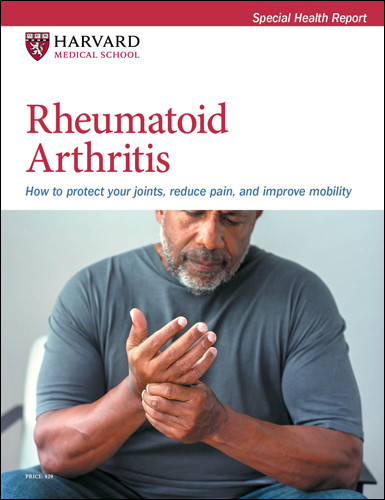Exercising with a flare-up of knee arthritis
Stay active by warming up, adjusting your exercise routine, and icing your knee after a workout.
- Reviewed by Anthony L. Komaroff, MD, Editor in Chief, Harvard Health Letter; Editorial Advisory Board Member, Harvard Health Publishing

You might know it well by now: the painful bloom of swelling and stiffness that signals a flare-up of knee osteoarthritis. When it strikes, and you muddle through the discomfort, you go easy on your knee and accept the idea that you’ll have to brace for limited activities until the flare settles down.
While that may be true for some activities, such as kneeling or squatting, it doesn’t mean you have to stop exercising to protect your knee. In fact, exercising is an important way to keep the joint flexible. You’ll just have to go about exercising a little differently while your knee arthritis is acting up.
For pointers, we turned to Christopher Morin, a physical therapist with Harvard-affiliated Spaulding Rehabilitation Hospital.
Q. What are the risks of exercising when knee arthritis flares?
A: The most significant risk is causing further irritation of the joint. Osteoarthritis is a long and slow degenerative process that happens when the cartilage or cushioning between knee bones wears out. Activities that irritate the joint shouldn’t worsen this degenerative change or cause structural damage, but they could cause greater discomfort and decreased function.
Q. What types of activities might irritate the knee?
A: You should try to reduce pressure and friction on your knee. Pressure would come from activities such as running, tennis, basketball, or walking long distances. Friction would come from activities like deep knee bending or knee lunges that require you to bend and hold a knee position for an extended period. Those activities can make your knee arthritis symptoms worse, and you’ll want to avoid that so the joint can calm down.
Q. What types of activities are safe when arthritis is bothering you?
A: It depends on your symptoms, their severity, and your overall fitness. Sometimes simply decreasing the physical stress of an activity is all it takes to adapt an exercise to a flare-up. So maybe play pickleball instead of tennis, or take brisk walks rather than going for a run.
But generally we like to encourage activities that relieve pressure and friction on the knee, such as riding a stationary bike, using an elliptical machine, practicing yoga, swimming, walking pain-free distances on flat terrain, or doing upper-body strength training or core strengthening.
Lower-body strengthening can also be quite useful. For example, stronger leg muscles help relieve knee pain, as they absorb some of the pressure you place on the knees.
But again, stay away from exercises that might irritate the knee. A general rule of thumb is that exercising shouldn’t increase your pain or swelling during or after the activity.
Q. Is there anything you should do before a workout when you have a knee arthritis flare?
A: Some people will take nonsteroidal anti-inflammatory medications such as ibuprofen (Advil, Motrin) before an activity. However, regular use of those medications is associated with stomach ulcers, internal bleeding, and increased risks of heart attack, stroke, or kidney failure.
Instead, it’s safer to warm up before activity. It loosens the knee joint and the muscles that act on it. A heating pad or hot shower can be a good start. Spending 10 minutes on a stationary bike is great, too. If your knee is still comfortable after the warm-up, you should be in good shape to work out.
Q. What should you do after a workout when knee arthritis is flaring?
A: Try icing your knee after a workout to decrease inflammation. But if you consistently find that you need to keep icing your knee in order to function for the remainder of the day, consider either taking a bit of time off from exercising or toning down your routine. That could mean changing the type of exercise you do or reducing the amount of time you spend exercising per workout. It may help to do a few 10-minute workouts each day rather than one 30- or 60-minute routine.
Listen to your body. Let pain be your guide. But avoid long periods of inactivity. Stay as active as you can.
Move of the month: Side-lying clam
Lie on your right side, knees bent so your heels are in line with your buttocks. Rest your head on your right arm on the floor. Keep your feet together, contract your abdominal muscles, and slowly lift your left knee up toward the ceiling. Pause, then slowly return to the starting position. Repeat 10 times, then do the same exercise on the other side. |
Image: © FatCamera/Getty Images
About the Author

Heidi Godman, Executive Editor, Harvard Health Letter
About the Reviewer

Anthony L. Komaroff, MD, Editor in Chief, Harvard Health Letter; Editorial Advisory Board Member, Harvard Health Publishing
Disclaimer:
As a service to our readers, Harvard Health Publishing provides access to our library of archived content. Please note the date of last review or update on all articles.
No content on this site, regardless of date, should ever be used as a substitute for direct medical advice from your doctor or other qualified clinician.


















